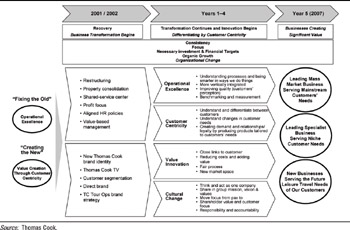Creating the New
In pulling off the financial turnaround, the senior executives at Thomas Cook recognized that they had gotten only partway through their transformational agenda. They had set the stage. Some said they had accomplished the easy part. What remained was to chart a strategic course that would catapult the organization from third place in its industry to the top (see Exhibit 6.9). Fontenla-Novoa described the organization’s vision and spirit: ‘‘We intend to become the leading vertically integrated leisure travel company in the UK with the lowest cost base and the highest customer satisfaction. We have gained confidence as an organization over the past 18 months, and we will continue to experience further change as the organization progresses toward meeting its strategic goals.’’

Exhibit 6.9: Thomas Cook 2003 strategy.
The organization launched several new initiatives to stimulate innovation. The team brought in an expert on value innovation from INSEAD, a leading European business school. She helped them brainstorm new opportunities to move into specialty businesses and to find new market spaces in an attempt to shift away from a me-too strategy.
Additionally, in the contract with Accenture, Trecroce had included an innovation requirement. Part of Accenture’s bonus depended on making a quarterly presentation to the executive team on breakthrough ideas. Trecroce and Christou were in discussions about the potential to turn the shared-services center into a revenue-generating operation. They were also toying with the idea of using Accenture’s patented Web-based simulation software to improve the sales effectiveness of its 10,000 retail and call-center staff. The senior team believed this could dramatically improve the company’s customer focus. Accenture had already helped Thomas Cook expand its corporate portal to improve its ability to communicate its one-company mission, vision, and values throughout the company. Finally, Trecroce had recently attended an Accenture review of new technologies and was mulling over the possibilities of using radio frequency identification (RFID) tags to improve luggage handling. While Trecroce was pleased with the activity, he wanted to see more initiative from Accenture on innovation. ‘‘Perhaps I should have given them more leeway,’’ he mused. ‘‘They have blinkers on around the business case, so they may not be able to see the forest.’’
Thomas Cook faced other challenges in addition to achieving the business case. Fontenla-Novoa ticked off the organization’s priorities going forward:
We need to deliver the results we set out to achieve in our business plan. That means we have to be aggressive with our cost base and aggressive with our suppliers. We have to talk to our customers and make sure we are delivering everything they expect from us and more. We need to continue to meet our financial performance targets. We need to continue to invest in our people. And finally, we need to further develop our road map for the future. We said we want to achieve 30 percent of our profits from the specialist businesses in the future. How are we actually going to do that?
Although Thomas Cook was in the early days of establishing joint planning processes with Accenture, Trecroce reflected on the role of the cosourcing arrangement in creating the organization’s future: ‘‘I am quite confident that the relationship with Accenture will stay in place for ten years. But it will reinvent itself several times in increments of three or four years.’’
The reason I wanted to share this story was to communicate the complexity and management challenges that executives take on when they decide to use an outsourcing initiative to support transformation. Let me just point out a few highlights that I think we can take away from the Thomas Cook example:
-
Control. In a business-critical situation, the management team believed they got more control, not less from outsourcing. What they really gotwas less direct say over worker tasks and more managerial control over decisions and cost structure.
-
Transition. The first 18 to 24 months of the cosourcing required high- intensity management. This was not a handoff; it was a hands-on experience.
-
Process Understanding. The transition process and the effort to design metrics drove Thomas Cook management’s understanding of the way the company worked to a level of detail that the senior leadership had never had before. This understanding positioned them to make sound decisions about strategic execution.
-
Financial Flexibility. By working with Accenture, the UK business unit found financial flexibility that an operating unit does not usually have. It has off-budget funds, which give it more latitude for innovation and experimentation.
-
Future View. Thomas Cook leaders held fast to their long-term and whole-of-business perspective. It’s easy to lose this in the press of a financial turnaround. They did not.
EAN: 2147483647
Pages: 135